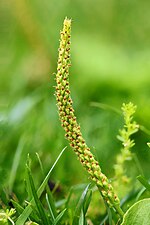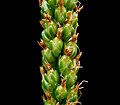| Plantago major | |
|---|---|

| |
| Conservation status | |
 Least Concern (IUCN 3.1) | |
| Scientific classification | |
| Kingdom: | Plantae |
| Clade: | Tracheophytes |
| Clade: | Angiosperms |
| Clade: | Eudicots |
| Clade: | Asterids |
| Order: | Lamiales |
| Family: | Plantaginaceae |
| Genus: | Plantago |
| Species: | P. major |
| Binomial name | |
| Plantago major L. | |
Plantago major, the broadleaf plantain, white man's footprint, waybread, or greater plantain, is a species of flowering plant in the plantain family Plantaginaceae. The plant is native to Eurasia.
The young, tender leaves can be eaten raw, and the older, stringier leaves can be boiled in stews and eaten.
Description

Plantago major is a herbaceous, perennial plant with a rosette of leaves 15–30 centimetres (6–12 inches) in diameter. Each leaf is oval-shaped, 5–20 cm (2–8 in) long and 4–9 cm (1+1⁄2–3+1⁄2 in) broad, rarely up to 30 cm (12 in) long and 17 cm (7 in) broad, with an acute apex, a smooth margin, and a distinct petiole almost as long as the leaf itself. There are five to nine conspicuous veins over the length of the leaf. The flowers are small, greenish-brown with purple stamens, produced in a dense spike 5–15 cm (2–6 in) long on top of a stem 13–15 cm (5–6 in) tall and rarely to 70 cm (28 in) tall.
Plantain is wind-pollinated and propagates primarily by seeds, which are held on the long, narrow spikes which rise well above the foliage. Each plant can produce up to 20,000 seeds, which are very small and oval-shaped, with a bitter taste.
Taxonomy
Broadleaf plantain is not closely related to the fruit also known as plantain, which is a kind of banana.
There are three subspecies:
- Plantago major subsp. major.
- Plantago major subsp. intermedia (DC.) Arcang.
- Plantago major subsp. winteri (Wirtg.) W.Ludw.
Distribution and habitat
The plant is native to most of Europe and northern and central Asia, but has widely naturalised elsewhere in the world.
Plantago major grows in lawns and fields, along roadsides, and in other areas that have been disturbed by humans. It does particularly well in compacted or disturbed soils. It is believed to be one of the first plants to reach North America after European colonisation. Reportedly brought to the Americas by Puritan colonizers, plantain was known among some Native American peoples by the common name "white man's footprint", because it thrived in the disturbed and damaged ecosystems surrounding European settlements. The ability of plantain to survive frequent trampling and colonize compacted soils makes it important for soil rehabilitation. Its roots break up hardpan surfaces, while simultaneously holding together the soil to prevent erosion.
The seeds of plantain are a common contaminant in cereal grain and other crop seeds. As a result, it now has a worldwide distribution.
Uses
The mature plant contains pliable and tough fibres that can be used in survival situations to make small cords, fishing line, sutures, or braiding.
Some cultivars are planted as ornamentals in gardens, including 'Rubrifolia' with purple leaves, and 'Variegata' with variegated leaves.
Edibility
The leaves are edible as a salad green when young and tender, but they quickly become tough and fibrous as they get older. The older leaves can be cooked in stews. The leaves contain calcium and other minerals, and 100 grams (3.5 ounces) of plantain contain approximately the same amount of beta-carotene as a large carrot. The seeds are so small that they are tedious to gather, but they can be ground into a flour substitute or extender.
Herbal medicine
Plantain contains phytochemicals including allantoin, aucubin, ursolic acid, flavonoids, and asperuloside. Plantain extract has been studied for its potential health effects.
Plantain leaves were used commonly in folk medicine for skin poultices on wounds, sores, or insect stings. The root was used for fever and respiratory infections.
Gallery
-
Growing in crack in sidewalk
-
 Close-up of reduced, grass-like flowers
Close-up of reduced, grass-like flowers
-
 Developing fruits
Developing fruits
-
Cultivar 'Rubrifolia'
References
- Maiz-Tome, L. (2016). "Plantago major". IUCN Red List of Threatened Species. 2016: e.T168960A1257878. doi:10.2305/IUCN.UK.2016-1.RLTS.T168960A1257878.en. Retrieved 18 November 2021.
- ^ Flora of Pakistan: Plantago major
- ^ Blamey, M. & Grey-Wilson, C. (1989). Flora of Britain and Northern Europe. ISBN 0-340-40170-2
- Elias, Thomas S.; Dykeman, Peter A. (2009) . Edible Wild Plants: A North American Field Guide to Over 200 Natural Foods. New York: Sterling. p. 79. ISBN 978-1-4027-6715-9. OCLC 244766414.
- Parnell, J. and Curtis, T. 2012. Webb's An Irish Flora. Cork University Press. ISBN 978-185918-4783
- Sauer, Leslie Jones (1998). The Once and Future Forest. Island Press. p. 49. ISBN 978-1-55963-553-0.
- ^ Samuelsen, Anne Berit (July 2000). "The traditional uses, chemical constituents and biological activities of Plantago major L. A review". Journal of Ethnopharmacology. 77 (1–2): 1–21. doi:10.1016/S0378-8741(00)00212-9. ISSN 0378-8741. PMC 7142308. PMID 10904143.
- ^ Flora Europaea: Plantago major
- ^ Natural History Museum: Plantago major
- ^ "Plantago major". Germplasm Resources Information Network. Agricultural Research Service, United States Department of Agriculture. Retrieved 16 December 2017.
- As a result, Plantago major has many common names. In addition to "broadleaf plantain" and "greater plantain", other common names include: common plantain, broad-leaved plantain, cart track plant, dooryard plantain, greater plantago, healing blade, hen plant, lambs foot, roadweed, roundleaf plantain, snakeroot, waybread, wayside plantain, and white man's foot prints. -- Britton, Nathaniel Lord; Addison Brown (1913). An Illustrated Flora of the Northern United States and Canada, Volume 3 (second ed.). Dover Publications, inc. p. 245.
- Joint Nature Conservation Committee: Greater Plantain Plantago major Linnaeus
- Botanical Society of Britain and Ireland Database Archived 2007-08-08 at the Wayback Machine
- Duke, James (2001). Handbook of Edible Weeds. CRC Press. p. 150. ISBN 9780849329463.
- Tilford, Gregory L.; Gladstar, Rosemary (1998). From Earth to Herbalist: An Earth-Conscious Guide to Medicinal Plants. Mountain Press. p. 163. ISBN 9780878423729.
- Tilford, Gregory L. (1997). Edible and Medicinal Plants of the West. Mountain Press. p. 112. ISBN 9780878423590.
- Huxley, A., ed. (1992). New RHS Dictionary of Gardening. ISBN 0-333-47494-5
- Scott, Timothy Lee; Buhner, Steven Harrod (2010). Invasive Plant Medicine: The Ecological Benefits and Healing Abilities of Invasives. Inner Traditions / Bear & Co. p. 253. ISBN 9781594773051.
- Vizgirdas, Ray S.; Rey-Vizgirdas, Edna (2005). Wild Plants Of The Sierra Nevada. University of Nevada Press. pp. 148–149. ISBN 9780874175356.
- ^ "Plantago". Drugs.com. 2020-09-23. Retrieved 2020-04-18.
- Duke, James A. (2001). "Plantago major". Handbook of Phytochemical Constituents of GRAS Herbs and Other Economic Plants. CRC Press. p. 471. ISBN 9780849338656.
- Centre for Mediterranean Cooperation (2005). A Guide to Medicinal Plants in North Africa. International Union for Conservation of Nature and Natural Resources (IUCN). p. 190. ISBN 9782831708935.
- Duke, James (2001). Handbook of Edible Weeds. CRC Press. p. 151. ISBN 9780849329463.
- Green, James (2000). The Herbal Medicine Maker's Handbook: A Home Manual. Chelsea Green Publishing. pp. 314–315. ISBN 9780895949905.
- Foster, Steven; Hobbs, Christopher (2002). A Field Guide to Western Medicinal Plants and Herbs. Houghton Mifflin Harcourt. p. 224. ISBN 9780395838068.
External links
- [REDACTED] Media related to Plantago major at Wikimedia Commons
| Herbs used as laxatives | |
|---|---|
| Anthraquinones | |
| Bulk-forming agents | |
| Sugar-containing herbs | |
| Other | |
| Taxon identifiers | |
|---|---|
| Plantago major |
|